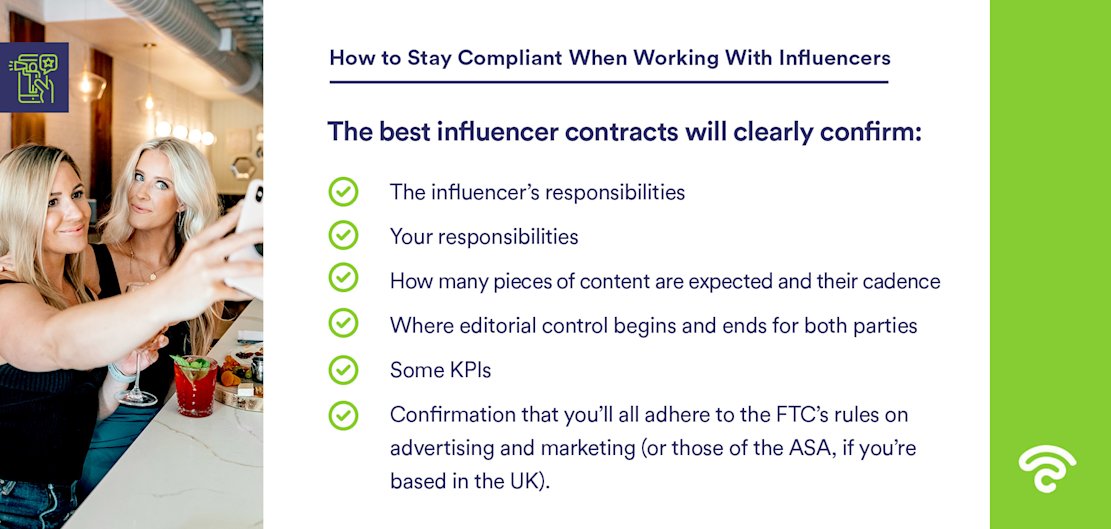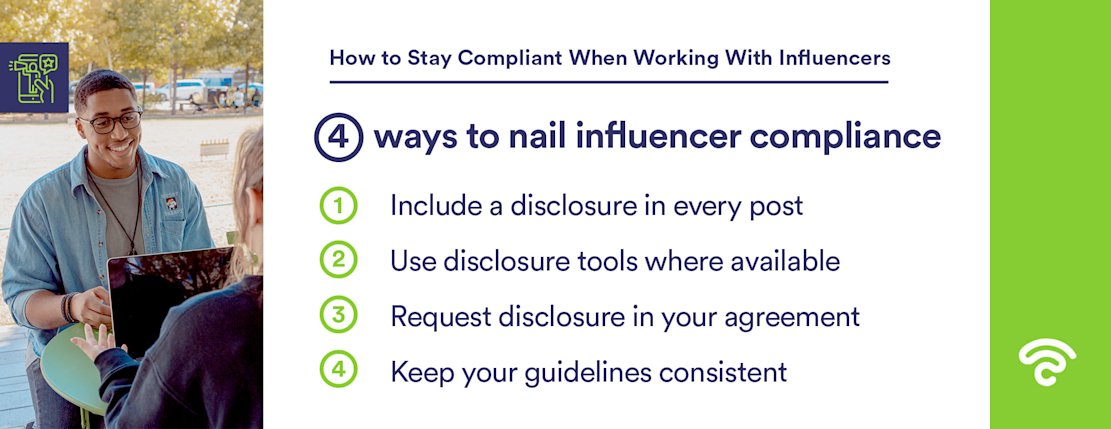Crafting an Influencer Contract for Your Venue
Influencer marketing is powerful for one very good reason: just 33% of consumers now trust traditional advertising, and that’s a percentage that’s likely to continue falling.
What’s more, 94% of brands who leverage influencers for their marketing campaigns describe it as an effective practice.

There’s just one problem: influencer marketing is largely unregulated.
It’s pretty easy to find influencers who will take freebies from you (and hardly surprising). You may get a few posts on Instagram or on blog posts, but if you don’t stick to the rules and do things ethically it’s not just the regulators you could be in trouble with, you may lose respect from your existing customers too.
Often, it’s no one’s fault. After all, it is rather easy to get carried away with the wonderful world of influencer marketing and forget about your legal and contractual obligations.
This is the only guide you need to stay compliant when working with influencers.
Disclaimer: it’s good news!
You might be thinking that it’s barely worth your time working with influencers if there are so many legal pitfalls and black holes into which your brand can fall, but the opposite is true.
Like everything in business, if you do your homework and get your ducks in a row, you won’t run into any problems.
Remaining compliant during influencer marketing is actually easy, providing you set everything straight from the outset and ensure there are no ambiguities or elephants in the room.
This requires nothing more than honesty, right from the start. So, begin by finding an influencer you like and whom you can trust (we’ve got a guide for that!).
Further reading: 10 Marketing Ideas For Your Bar
How to get your influencer contract right
Influencer contracts shouldn’t be akin to War and Peace. They should be simple one-pagers that clearly outline everyone’s responsibilities. The best influencer contracts will clearly confirm:
- the influencer’s responsibilities;
- your responsibilities;
- how many pieces of content are expected and their cadence;
- where editorial control begins and ends for both parties;
- some KPIs; and
- confirmation that you’ll all adhere to the FTC’s rules on advertising and marketing (or those of the ASA, if you’re based in the UK).
The key word here is ‘specificity’, because there can’t be any assumptions made or corners cut when it comes to influencer marketing. Even if part of the deal results in you compensating the influencer, that has to be clearly noted in the contract and the requirements for revealing this to the audience made abundantly clear.

Using the right advertising hashtags
The FTC and ASA require that any content that’s considered advertorial must feature the #AD hashtag.
You need to use that hashtag if the following two statements are true: the influencer is getting paid for the post; and you have a degree of control over the content itself.
Payment might be monetary, but it could also be a discount code or a free gift. And the control you have over the content could be as minor as providing the title of a post to full editing and proofing.
Another important hashtag is #GIFT. This should be used when the influencer has been paid (be it in monetary terms or some other form of reward) for featuring a product, but without any editorial control on behalf of the brand.
The point of these hashtags is to make it immediately obvious to the audience that the content they’re engaging with is an advert. It therefore needs to be at the beginning of the post, in the title, and not lost at the bottom of a massive paragraph or at the end of a video.
There are also some hashtags you should avoid, including #SP or #SPONSORSHIP, simply because they’re too ambiguous.
Influencer disclosure guidelines explained
In 2017, over 90 warnings were issued to social media influencers who didn’t disclose what they were being compensated for in exchange for coverage of a product, service or brand.
This led to the FTV reiterating their guidelines for compliance, and while these relate specifically to the influencer themselves, it’s worth being aware of what they need to do to remain compliant.
To avoid receiving a ticking-off which could in turn reflect poorly on your brand, influencers need to:
- ensure their disclosures are unambiguous;
- make all disclosures highly visible in their content; and
- steer clear of disclosures which can be easily missed by viewers, listeners or readers.
It’s therefore important to include these topics of discussion early on with influencers. If they’re legit and understand the rules, they’ll know them like the back of their hand.
In fact, if you want to steer clear of influencers who might be more willing to break the rules, look out for those who brush off any mention of the FTC. “Ah, everyone says that - you don’t need to worry”, shouldn’t inspire confidence.
If, alternatively, an influencer gets to the point of compliance before you do, you’re in good hands!
The same goes for any content or brands you spot online who clearly aren’t taking the rules seriously. No matter how big they are or how much content they’re putting out which appears to go against the FTC’s rules, you shouldn’t follow suit. They’ll get what’s coming to them sooner or later.

4 ways to nail influencer compliance
It’s far better to be safe than sorry. So, let’s consider four super-simple ways to work with influencers in the most compliant fashion possible.
1. Include a disclosure in every post
The aforementioned hashtags need to be used in every single influencer post you commission. Whether it’s a one-off piece of content or something which forms part of a series on the same product, make sure that hashtag is front-and-centre.
Remember - make sure it sits at the start of the content. The FTC actually requires you to put the disclosure within the first three lines of any social media post.
2. Use disclosure tools where available
If you’re using YouTube as part of your influencer marketing strategy, it has a built-in disclosure tool. By simply clicking a checkbox during the upload process, YouTube will automatically inform the audience that the video they’re watching contains a paid endorsement of some kind.
Other platforms offer similar tools, so save yourself and the influencer some time by using them. It’s the most accurate and reliable way to remain compliant.
3. Request disclosure in your agreement
One of the most important elements of the contractual agreement we mentioned earlier is the request for disclosure.
Make sure it’s obvious and tied in with the influencer’s signature. That way, you have a binding contract which states that the influencer must disclose the advertising element of the content each and every time they feature your brand.
4. Keep your guidelines consistent
You may end up working with more than one influencer, therefore make sure your guidelines and contractual arrangements are consistent.
The guidelines should be clear on what the influencer can and can’t do, and what they’re obliged to do. But they shouldn’t be tailored for each influencer when it comes to disclosure; keep that section of the contract completely in line with the FTC’s requirements.
If the influencer refuses to sign the contract based on the compliance element, don’t work with them.
Influencer marketing continues to rocket in popularity. As we’ve hopefully demonstrated today, remaining compliant is actually a lot easier than you might think.
Be a stickler for the rules: it’ll pay you back handsomely with great reach, engagement and interaction with your brand.
Grow your venue with WiFi Marketing
Beambox helps businesses like yours grow with data capture, marketing automation and reputation management.
Sign up for 30 days free

